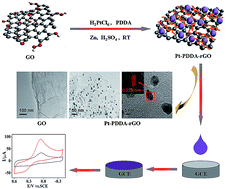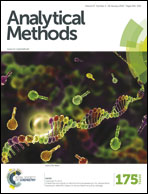Green and rapid synthesis of a water-dispersible Pt–reduced graphene oxide hybrid material for hydrogen peroxide detection†
Abstract
A kind of water-dispersible Pt nanoparticle–reduced graphene oxide hybrid material (Pt–rGO) has been prepared by in situ reduction of both graphene oxide (GO) and the Pt precursor in acidic solution using metallic Zn powder. Great amounts of highly dispersed Pt nanoparticles could be well loaded on the surface of the graphene, as revealed by transmission electron microscopy (TEM). In addition, the nanocomposites were also characterized by Fourier transform-infrared spectrometry (FT-IR), ultraviolet-visible absorption spectrometry (UV-Vis), cyclic voltammetry (CV) and electrochemical impedance spectroscopy (EIS). The experimental results demonstrated that the constructed sensor exhibited excellent catalytic activity toward H2O2, and obtained a wide linear range from 1.0 × 10−9 to 1.4 × 10−3 M with low limit of detection (LOD) of 3.4 × 10−10 M, which was superior to that obtained with other H2O2 electrochemical sensors reported previously. Furthermore, it can also be successfully applied to real sample analysis in human serum with satisfactory recoveries, and the electrocatalytic mechanism of the constructed sensor was briefly discussed.


 Please wait while we load your content...
Please wait while we load your content...